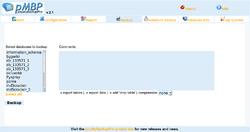phpMyBackupPro
| phpMyBackupPro
|
|
|---|---|
 Internet-based creation and management of MySQL backups |
|
| Basic data
|
|
| developer | phpMyBackupPro Project |
| Current version | 2.5 (March 31, 2015) |
| operating system | all with PHP and MySQL |
| category | Database management system , backup |
| License | GPL |
| German speaking | Yes |
| www.phpMyBackupPro.net | |
phpMyBackupPro (abbreviated pMBP ) is a free PHP application (open source) to create and manage MySQL - backups . Administration can be done with any common browser that supports JavaScript . This means that phpMyBackupPro can be used on a web server over the Internet without the user having to have rights to run the MySQL command line client. Especially with rented web hosting , as it is mostly used by smaller companies and private individuals, it is seldom the case that the customers are allowed to execute the command mysqlor directly mysqldump. A typical problem with the execution of an application on a PHP server is also with phpMyBackupPro the limited time a PHP script has to execute.
As well as phpMyAdmin can phpMyBackupPro where no installation on the respective installation by the user on web servers hosting - providers will be offered.
phpMyBackupPro is licensed under the GNU General Public License and is available in several languages (including German). However, the language packs must also be downloaded and copied into the installation directory. The default installation language is English.
Range of functions
The main functions of phpMyBackupPro include creating backups, restoring existing backups to the database and managing the created backups.
The creation of the backups can be automated by integrating a small PHP script into a website created by the user or by using a cron job. The MySQL backups can either be saved as plain text files, as files in gzip format or as ZIP files. When creating the backups, they can also be transferred to an FTP server or sent by email if desired. In addition to the MySQL databases, directories and files on the web server can also be saved to another server via FTP or sent via e-mail. These backups of the file system can also be automated.
If the problem arises that more time is required to restore a backup than PHP allows for the execution of phpMyBackupPro, the process is aborted. To prevent this, a function is available, via which phpMyBackupPro calls itself cyclically so that even large to very large databases can be restored. There is no equivalent function for backing up very large amounts of data, as this method would run the risk of the databases becoming inconsistent . The problems with creating backups of large databases can only be avoided by a corresponding configuration of the PHP installation, which many providers of free web space allow their users (often limited).
The functions of phpMyBackupPro can be configured in a variety of ways via the browser. PhpMyBackupPro can also be preinstalled by webspace providers so that every customer can use phpMyBackupPro via a single installation. It is also possible to create and restore backups from multiple MySQL servers or multiple accounts on the same MySQL server.
Development milestones
- 0.2 (April 2003) - First internal release
- 0.3 (June 7, 2004) - First public release
- 0.6 (June 29, 2004) - First version with built-in user authentication
- 1.0 (July 17, 2004) - Large expansion of the range of functions; Resource-saving backup process
- 1.2 (November 29, 2004) - ZIP format for backups possible; Selection of skins possible
- 1.6 (May 17, 2005) - Extension of the configurability via system variables
- 1.8 (February 13, 2006) - Improved performance when importing backups
- 2.0 (March 15, 2007) - multi-user installation; Large database support
- 2.2 (October 5, 2011) - Update for PHP 5.x; UTF-8 support; improved configuration of cron jobs